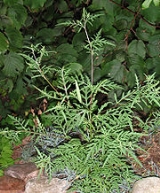
Ambrosia psilostachya
Encyclopedia
Ambrosia psilostachya is a species of ragweed
known by the common names Cuman ragweed, perennial ragweed, and western ragweed.
It is native to most of North America including all of southern Canada, nearly all of the continental United States, and the northern half of Mexico. It is a common plant in many habitat types, including disturbed areas such as roadsides. It can be found in parts of Eurasia as an introduced species
. This is an erect perennial herb growing a slender, branching, straw-colored stem to a maximum height near two meters, but more often remaining under one meter tall. Leaves are up to 12 centimeters long and vary in shape from lance-shaped to nearly oval, and they are divided into many narrow, pointed lobes. The stem and leaves are hairy. The top of the stem is occupied by an inflorescence
which is usually a spike. The species is monoecious
, and the inflorescence is composed of staminate
(male) flower heads with the pistillate
heads located below and in the axils of leaves. The pistillate heads yield fruits which are achene
s located within oval-shaped greenish-brown burs
about half a centimeter long. The burs are hairy and sometimes spiny. The plant reproduces by seed and by sprouting up from a creeping rhizome-like
root system. This plant had a number of medicinal uses among several different Native American groups.
Ragweed
Ragweeds are flowering plants in the genus Ambrosia in the sunflower family Asteraceae. Common names include bitterweeds and bloodweeds....
known by the common names Cuman ragweed, perennial ragweed, and western ragweed.
It is native to most of North America including all of southern Canada, nearly all of the continental United States, and the northern half of Mexico. It is a common plant in many habitat types, including disturbed areas such as roadsides. It can be found in parts of Eurasia as an introduced species
Introduced species
An introduced species — or neozoon, alien, exotic, non-indigenous, or non-native species, or simply an introduction, is a species living outside its indigenous or native distributional range, and has arrived in an ecosystem or plant community by human activity, either deliberate or accidental...
. This is an erect perennial herb growing a slender, branching, straw-colored stem to a maximum height near two meters, but more often remaining under one meter tall. Leaves are up to 12 centimeters long and vary in shape from lance-shaped to nearly oval, and they are divided into many narrow, pointed lobes. The stem and leaves are hairy. The top of the stem is occupied by an inflorescence
Inflorescence
An inflorescence is a group or cluster of flowers arranged on a stem that is composed of a main branch or a complicated arrangement of branches. Strictly, it is the part of the shoot of seed plants where flowers are formed and which is accordingly modified...
which is usually a spike. The species is monoecious
Plant sexuality
Plant sexuality covers the wide variety of sexual reproduction systems found across the plant kingdom. This article describes morphological aspects of sexual reproduction of plants....
, and the inflorescence is composed of staminate
Stamen
The stamen is the pollen producing reproductive organ of a flower...
(male) flower heads with the pistillate
Gynoecium
Gynoecium is most commonly used as a collective term for all carpels in a flower. A carpel is the ovule and seed producing reproductive organ in flowering plants. Carpels are derived from ovule-bearing leaves which evolved to form a closed structure containing the ovules...
heads located below and in the axils of leaves. The pistillate heads yield fruits which are achene
Achene
An achene is a type of simple dry fruit produced by many species of flowering plants. Achenes are monocarpellate and indehiscent...
s located within oval-shaped greenish-brown burs
Burr (fruit)
A bur is a seed or dry fruit in which the seeds bear hooks or teeth which attach themselves to fur or clothing of passing animals or people. The hooks or teeth can be irritants and very hard to get off of clothing, such as wool or cotton...
about half a centimeter long. The burs are hairy and sometimes spiny. The plant reproduces by seed and by sprouting up from a creeping rhizome-like
Rhizome
In botany and dendrology, a rhizome is a characteristically horizontal stem of a plant that is usually found underground, often sending out roots and shoots from its nodes...
root system. This plant had a number of medicinal uses among several different Native American groups.

